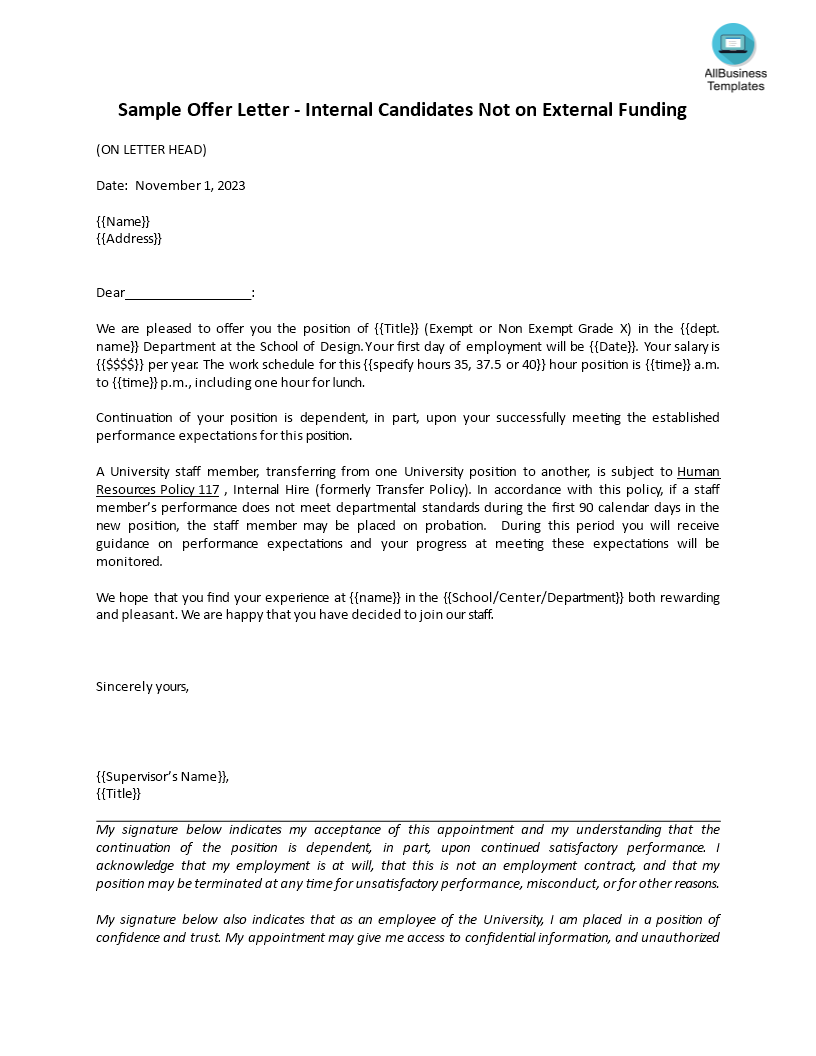Staff Internal Transfer Letter
Save, fill-In The Blanks, Print, Done!

Download Staff Internal Transfer Letter
Microsoft Word (.doc)Or select the format you want and we convert it for you for free:
Other languages available:
- This Document Has Been Certified by a Professional
- 100% customizable
- This is a digital download (78 kB)
- Language: English
- We recommend downloading this file onto your computer.
How to write a staff internal transfer letter? Have you been searching for a template for staff internal transfer letters? This template will outline the employee's current job responsibilities and duties, as well as the potential role they are applying for. It should also include the employee's qualifications and why they are qualified for the role. Download this staff internal transfer letter template now!
A staff internal transfer letter is a written document that an employee uses to formally request a transfer to a different position or department within the same organization or company. This letter is typically addressed to the employee's current supervisor or manager and outlines the employee's desire to change roles or departments while remaining employed by the same company. The letter serves as a formal communication of the employee's intentions and provides an opportunity to explain the reasons for the transfer request.
Here are some key elements typically included in a staff internal transfer letter:
- Employee's Information: This includes the employee's name, current position, department, and contact information.
- Current Supervisor's Information: Provide the name and title of the employee's current supervisor or manager.
- Reasons for the Transfer: Clearly state the reasons for the transfer request. This might include career development goals, a desire for a change in responsibilities, alignment with personal interests, or other relevant factors.
- Destination Position or Department: Specify the desired position or department to which the employee wishes to transfer. Provide the position title, department name, and any other relevant details.
- Discussion with Current Supervisor: Mention if you have already discussed the transfer request with your current supervisor. If so, briefly summarize the outcome of that conversation.
- Commitment to Transition: Express your commitment to ensuring a smooth transition if the transfer is approved. This may include completing current projects, training a replacement, or other transitional tasks.
- Meeting Request: Request a meeting with relevant parties, such as your current supervisor and the supervisor of the destination department, to discuss the transfer request in more detail.
- Contact Information: Provide your contact information, including your phone number and email address, to facilitate further communication.
- Closing and Signature: Conclude the letter with a professional closing (e.g., "Sincerely") and sign your name.
A staff internal transfer letter should be clear, concise, and professional. It's important to address the letter to the appropriate individuals within your organization who have the authority to approve or discuss your transfer request. After sending the letter, be prepared to engage in discussions and meetings with relevant parties to further explore the possibility of the transfer and to ensure a smooth transition if it is approved.
Download this human resources staff internal transfer letter template now!
Also interested in other HR templates? Browse through our database and have instant access to hundreds of free and premium HR documents, HR forms, HR agreements, etc
DISCLAIMER
Nothing on this site shall be considered legal advice and no attorney-client relationship is established.
Leave a Reply. If you have any questions or remarks, feel free to post them below.
Related templates
Latest templates
Latest topics
- Excel Templates
Where do I find templates for Excel? How do I create a template in Excel? Check these editable and printable Excel Templates and download them directly! - GDPR Compliance Templates
What do you need to become GDPR compliant? Are you looking for useful GDPR document templates to make you compliant? All these compliance documents will be available to download instantly... - Google Docs Templates
How to create documents in Google Docs? We provide Google Docs compatible template and these are the reasons why it's useful to work with Google Docs... - IT Security Standards Kit
What are IT Security Standards? Check out our collection of this newly updated IT Security Kit Standard templates, including policies, controls, processes, checklists, procedures and other documents. - Letter Format
How to format a letter? Here is a brief overview of common letter formats and templates in USA and UK and get inspirited immediately!
cheese

